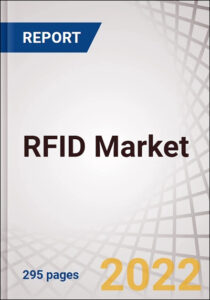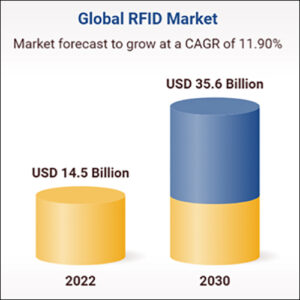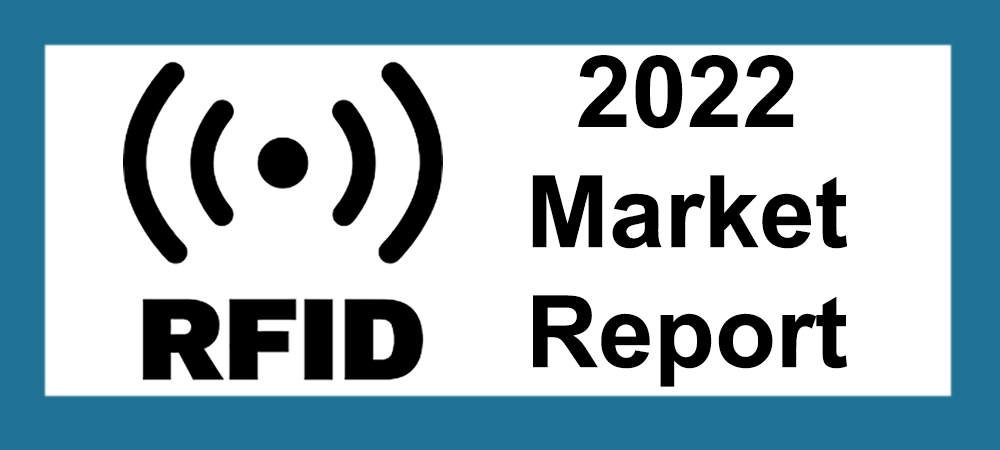 ResearchAndMarkets.com has released a new report titled “RFID Market by Offering (Tags, Readers, Software & Services), Tag Type (Passive, Active), Wafer Size, Frequency, Form Factor (Card, Implant, Key Fob, Label, Paper Ticket, Band), Material, Application & Region – Global Forecast to 2030,” which projects that the market for radio frequency identification (RFID) technologies will reach $35.6 billion by 2030, up from $14.5 billion in 2022, with a compound annual growth rate (CAGR) of 11.9 percent during that span of years. The ultra-high frequency (UHF) segment of the market by frequency is expected to grow at the highest CAGR during the forecast period.
ResearchAndMarkets.com has released a new report titled “RFID Market by Offering (Tags, Readers, Software & Services), Tag Type (Passive, Active), Wafer Size, Frequency, Form Factor (Card, Implant, Key Fob, Label, Paper Ticket, Band), Material, Application & Region – Global Forecast to 2030,” which projects that the market for radio frequency identification (RFID) technologies will reach $35.6 billion by 2030, up from $14.5 billion in 2022, with a compound annual growth rate (CAGR) of 11.9 percent during that span of years. The ultra-high frequency (UHF) segment of the market by frequency is expected to grow at the highest CAGR during the forecast period.
According to the research, product launches and developments were the key strategies adopted by leading players in the RFID market from January 2018 to May 2022. Other strategies adopted included partnerships, collaborations, acquisitions and expansions. The RFID market is witnessing a rise in demand for hybrid solutions, the report indicates. Such solutions are designed to overcome some of the challenges associated with a single technology-based RFID system, since they enable end users to deploy RFID technology at blind spots, while reducing infrastructure requirements by also utilizing existing technologies, such as Wi-Fi or GPS.
RFID-based Internet of Things (IoT) solutions are gaining momentum, ResearchAndMarkets reports, as multiple forces drive adoption. The declining cost of RFID tags, widely accepted IP networks and new business opportunities have contributed to a rising demand for such solutions, according to the study. The technologies can track physical assets to improve business processes and cost efficiencies in numerous industries and government organizations.
 The study segments the RFID market by product, tag and region, with the tag subsegment divided into wafer size, tag type, frequency, application, form factor and material. The 8-inch or 200-millimeter wafer size segment held the highest market share in 2021, and such wafers are the most-produced, according to the research. The top three players in the market—Alien Technology, Impinj and NXP Semiconductors—use 8-inch wafers for chip production. The report shows that many businesses have been reluctant to shift to 12-inch wafers, as that would incur a large amount of investment for equipment.
The study segments the RFID market by product, tag and region, with the tag subsegment divided into wafer size, tag type, frequency, application, form factor and material. The 8-inch or 200-millimeter wafer size segment held the highest market share in 2021, and such wafers are the most-produced, according to the research. The top three players in the market—Alien Technology, Impinj and NXP Semiconductors—use 8-inch wafers for chip production. The report shows that many businesses have been reluctant to shift to 12-inch wafers, as that would incur a large amount of investment for equipment.
The market for other wafer sizes is expected to grow in the coming years, with a corresponding reduction in prices, mostly of 12-inch wafers. This will bridge the gap between 8- and 12-inch wafers, the study indicates, and it will help to smooth the industry’s transition to the 12-inch size. In late 2016, NXP began providing 12-inch wafers for long-range RFID chips in addition to the 8-inch variety—which, the report says increased supply capacity, improved assembly quality and efficiency, while decreasing manufacturing waste and electricity needs. Avery Dennison was the first company to provide inlays with NXP’s 12-inch offerings.
The 295-page report includes statistics pertaining to the RFID market based on offering, tag type, wafer size, frequency, form factor, material, application and region. Major drivers, restraints, opportunities and challenges for the market are provided as well, and the report includes illustrative segmentation, analysis and forecast based on market segments. Learn more about the report at the company’s website.


